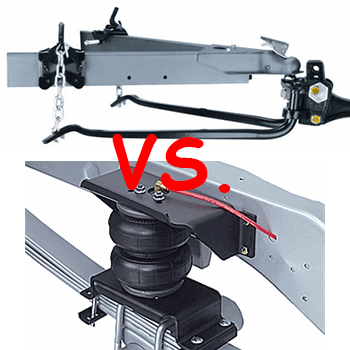
 There has been much controversy over the use of air springs along with a weight distribution system (WDS) when towing conventional trailers.
There has been much controversy over the use of air springs along with a weight distribution system (WDS) when towing conventional trailers.
Several RVers have been using this combination setup while towing a conventional trailer and they will tell you it works fine for them.
Often a flippant response to a questioner is “you need air bags” or “you need air springs” when shown some pictures of their sagging hookup with a WDS.
What makes these responses even worse is that rarely do these so-called RVing helpers describe how to use air springs with a WDS.
Does one need air springs with the WDS?
From the beginning of my research on this topic, it has remained my belief that a vehicle with a properly equipped and adjusted WDS should never need air springs.
Expert Michael H. at etailer.com states:
“I do not recommend using airbags and weight distribution at the same time.” [sic]
He continues to state:
“Air bags and similar products are best for carrying loads in a vehicle, not towing a trailer. When you use both at the same time, the airbags and weight distribution systems can work against each other, and you will not get the full benefits of either system.” [sic]
Bruce Smith at Hard Working Trucks states:
“Trying to use the air-helper springs for added weight support while using a weight-distributing hitch will only create more handling issues.” [sic]
Let’s take a look at some real dynamics in the difference between using a WDS or air springs to level a conventional trailer hookup.
Did you notice that when using the WDS…
The rear of the truck was only down 1¼ inches from the baseline, and the front of the truck was down, yes, DOWN 1/8 inches from the baseline.
Therefore the question could be “will raising the rear of the truck to baseline with air springs make any improvement?”
Unless someone can present any engineering or scientific proof, I doubt there will be a noticeable difference by raising the rear of the truck 1¼ inches. It is likely that additional air in the air springs will stiffen the ride.
However, as I mentioned above, there are those who feel better when the tow vehicle is perfectly level. It does make me wonder if these RVers have the correct WDS or is it adjusted correctly. I’m not writing about this to argue, but to provide differing points of view that may help anyone with the decision process.
I have air springs, what do I do?
If your tow vehicle came with a factory installed air spring system, read your owner’s manual thoroughly. Read every caution and warning. There should be specific information concerning towing conventional trailers.
If your tow vehicle has non-OEM air springs, every expert resource I’ve read and listened to has stated to maintain minimum required air pressure in the air springs—this is usually five PSI. If you want more, it is important to set the air pressure and leave it there before connecting or adjusting the WDS.
I contacted the folks at Fastway Trailer Products and got the answer on what to do when a heavy load is carried in the bed of the truck while towing a conventional trailer. This is their reply:
When you add air to the air bags (rear axle) after you have set up the hitch for weight distribution, you will decrease the amount of weight distribution you are getting from the hitch.
The only way to avoid this is to inflate the air bags first, then set up the weight distribution.
In your example, we recommend adding the weight to the truck, inflating the air bags to your desired level, and then going through the steps of setting up the weight distribution hitch. If you are adding the weight after you have set up your hitch, we recommend that instead of inflating the air bags, you adjust the hitch to give you slightly more weight distribution. This would be simply done on an e2 hitch by raising the L-brackets.
Keep in mind that some of this additional weight will now be carried by the hitch, and some by the rear axle. Care should be taken that ratings are not exceeded for either. This will also reduce the amount of tongue weight you are able to carry.
The potential danger of having more than the minimally required air pressure in the air springs is that in the event of an air spring system failure while towing, a sudden loss of air could change the driving condition and cause one to lose control of the vehicle.
In the future, I hope to provide an expert video that will explain the best way to use air springs with the WDS.
I vehemently disagree!
On one particular air spring manufacturer's website, they state:
Doing so will change the dynamics of the WDS. I refer you back to what Michael H. and Bruce Smith stated above.“When the bars cannot be adjusted tightly enough to achieve similar or identical vehicle-height reduction, add air to the air springs to bring the vehicle back to the correct height and balance.”
©2011-2025 Fifth Wheel Street and Fifth Wheel St. All Rights Reserved. Use of this website constitutes acceptance of the Privacy Statement and Terms and Conditions of Use.